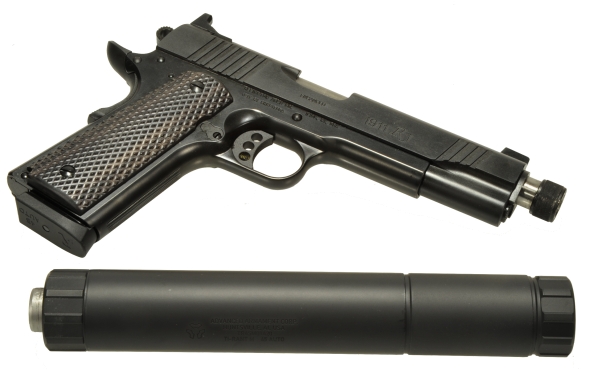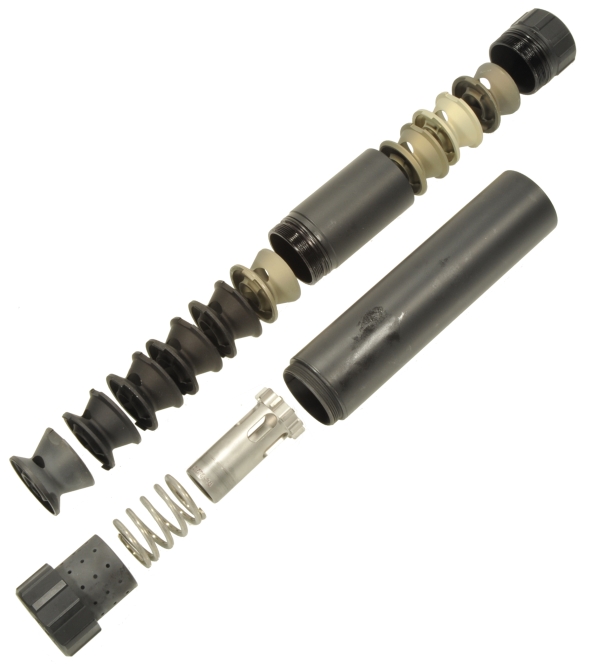
Hiram Percy Maxim designed the first firearm suppressor. He was subsequently awarded a patent for a “silent firearm” and his company went on to produce 2,500 product models that saw widespread government and civilian use. While Maxim’s achievements were laudable, it was a 1979 20/20 interview with the enigmatic Mitchell WerBell III that piqued my interest in silencers.
A quintessential covert operative, WerBell was associated with the Office of Strategic Services and Central Intelligence Agency, a shadow general during the war in Vietnam traveling from Thailand to Vietnam and Cambodia training special operations personnel and devising mission specific weapon’s systems.
In private sector, WerBell reportedly worked for Batista’s Cuba, the Dominican Republic, on behalf of Haiti exiles to oust “Papa Doc” Duvalier, Guatemala, and for Bahamian secessionists in their effort to create a new country. He handled corporate client’s problems in foreign facilities. He trained covert operatives at his “farm” in Georgia, just outside of Atlanta. In 1967, WerBell and Gordon Ingram combined a WerBell designed suppressor with Ingram’s M-11 machine gun and formed the company Defense Services to market products to world militaries 1) .
Is all of the above true and correct? In reality, there is probably no good documentation of WerBell’s history, activities and/or enterprises, other than interviews conducted with WerBell… the words of a man whose career and persona was based upon strategic deception and misrepresentation.
The reality of silencer history can be found within the Maxim context; a widely used accessory for any firearm user. We put mufflers even on leaf blowers because they would be disturbing to us and others around us without them. Unfortunately, it is gangster movies and the history of people like WerBell, that have stigmatized the use of silencers by private citizens.
Why would anyone want a silencer?
I’m very fond of my hearing, although over the years we seem to have gone our separate ways. Too many years of standing next to screaming jet engines, working in heavy industries, and enjoying firearms, have no doubt caused the estrangement. Silencers can help.
Health – Ear protection in the form of head gear and ear plugs helps, but a day of shooting still leaves me responding to my wife’s every word at the dinner table with “Huh?”, “What” and my wife’s all time favorite, “Are you talking to me?”. A silencer can prevents a shooter from a temporary hearing threshold shift; OSHA a shift of 10dB in hearing threshold at 2000, 3000, and 4000 Hz in either ear. Use of a suppressor can also prevent irreversible hearing loss that could result from the unsuppressed report of a single, but very loud shot.
Safety – During the course of an operation, military and law enforcement teams must be able to communicate even under live fire conditions. The reduced noise levels of suppressed weapons makes that vital communication possible. By the same token, an instructor training a class of new shooters can walk behind the firing line communicating with students. A hunter can get both health and safety benefits by using a silencer to reduce noise and, without the need to wear headsets or ear plugs, be more aware of his or her surroundings.
Enhanced performance – Silencers reduce recoil and muzzle jump which contribute to improve shooter accuracy and faster follow up shots. Shooting this 45 Auto, as an example, it was easy to shoot while keeping both eyes and watching bullets hit a target. Some silencers improve a firearm’s mechanical accuracy by stabilizing barrel harmonics and reducing muzzle gas pressure that can destabilize a bullet.
Hunting and self defense camouflage – Silencers are more effective at containing muzzle flash than a flash hider. This is useful in low light, or night hunting where permitted, as well in some self defense circumstances. The lack of muzzle flash preserves the shooter’s night vision and helps to conceal his or her position.
Who can own a silencer?
That is actually a two or more part question. As a federal consideration, under constraints of the National Firearms Act of 1934, to own a silencer a person must meet the following criteria: be at least 21 years of age, be a legal resident of the United States, be legally eligible to purchase a firearm and reside in one of the 39 states that permit private ownership.
The following 39 states permit private ownership of silencers: AL, AR, AK, AZ, CO, CT, FL, GA, ID, IN, KS, KY, LA, ME, MD, MO, MS, MT, ND, NE, NV, NH, NM, NC, OH, OK, OR, PA, SC, SD, TN, TX, UT, VA, WA, WI, WV, and WY. With the exception of AL, CT, FL, GA, ME, MI, NH, and OH, hunting with a silencer is also permitted. Of the states that do not allow private ownership, CA, IA and MA permit Class 3 dealers and Class 2 manufacturers to possess silencers.

A silencer can be registered to an individual, a living trust or a corporation. A class 3 dealer is selected in state of residence. Product is selected and the dealer provides duplicate ATF Form 4s, the buyer secures a set of passport type photos. The local chief law enforcement officer, typically chief of police or sheriff, signs off on the completed form 4’s and completes the finger print cards. Once completed, the buyer sends all off to the Department of the Treasury along with a check for $200 to cover the one time cost of the transfer tax. Then the buyer waits… three to six months. None of this process is difficult or particularly trying, it just takes a little patience and a tolerance for the hurry up and wait of government process.
We all drive around with silencers…
There are many brands, types and capacities of suppressors, but fundamentally they function like a motor vehicle’s muffler. Silencers contain muzzle exiting gases, allowing them to expand and cool before being released into the atmosphere with much less energy and noise. There is a bit more going on inside of the Ti-Rant 45-M that makes it unique as a silencer.
The Ti-Rant 45-m is modular and may be configured for different levels of suppression. Without tools, and in a matter of a few seconds, the silencer can be converted from full size 8.74″ to a compact 6.75″. The outer tube is made of Titanium, the blast baffle is made of heat treated SCARmor™coated stainless steel, the balance of the baffles are anodized aluminum; all of the parts in the assembly are indexed for alignment and positioning.

The Ti-Rant incorporates the ASAP system; Assured Semi-Automatic Performance System. Its purpose is to counteract the effect of the weight of the silencer on a tilting barrel design to assure reliable cycling. The piston adapter is available in a variety of popular threads and permits the use of the Ti-Rant with .45 caliber, .40 caliber and 9mm firearms. In 45 Auto trim, only standard pressure ammo should be used.
|
Model |
Ti-Rant 45M |
| Calibers | 9mm, 40 S&W, 45 Auto |
| Weight Full/Compact | 13.0 Oz./11.3 Oz. |
| Length Full/Compact | 8.74″ / 6.75″ |
| Tube Diameter | 1.38″ |
| Tube Material | Grade 9 Titanium |
| Tube Finish | Cerakote |
| Baffles | 17-4 PH Stainless/7075-T6 Aluminum |
| Attachment | ASAP Piston System |
| Reduction Compact | 18 dB Dry / 28dB Wet |
| Reduction Full | 30 dB Dry / 41 dB Wet |
| MSRP | $849.99 |
The Advanced Armament Corp. Ti-Rant is easy to install and to take down and clean when required. Configuring for wet operation further reduces noise and port flash. Water, high temp oil or grease, and/or wire pulling gel can be used as an agent to provide up to 30% greater noise reduction. The basic method, with the silencer removed, is to pour a 5cc cap full of water down the rear of the unit, then rotate it to spread the water evenly over the baffle stack. The water charge lasts for approximately 50 rounds and will remain in the unit for up to three days.
We’ll take a break here, pile up some ammo, set up a dB meter, chronograph and targets, find a bottle of water and see how it all turns out.
Advanced Armament Corporation’s Ti-Rant 45M Part 1
Advanced Armament Corporation’s Ti-Rant 45M Part 2

Email Notification